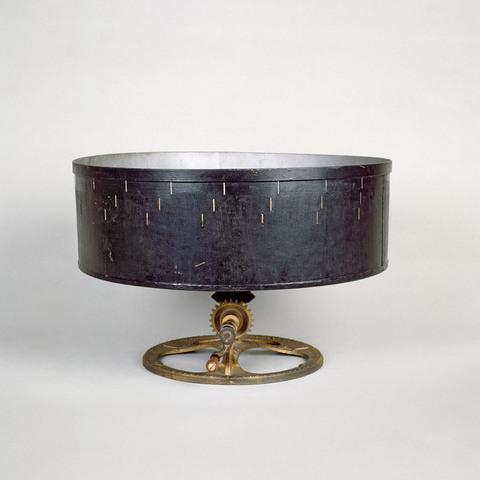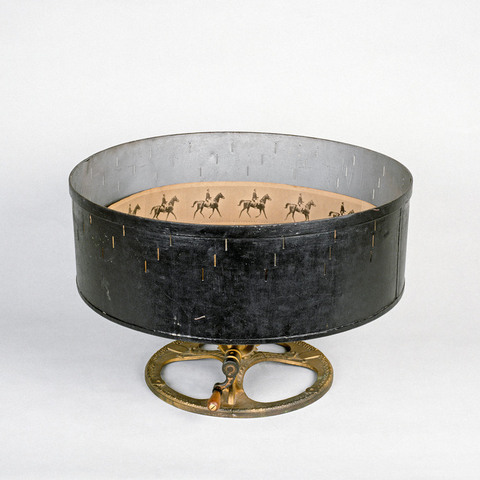Zootrope
Fiche détaillée
Type de l'appareil
grand tambour métallique portant trois séries en diagonales de minces fentes obturatrices (21 fentes supérieures, 20 fentes médium, 19 fentes en bas, 60 fentes en tout) pour effets analogues à la roue de Faraday ; pour bande de 180 cm de longueur ; pied en fonte ornementé et doré ; manivelle d'entraînement
Auteurs
Anschütz Ottomar
Lissa, Posen et Prusse, Berlin, 14 Unter den Linden
Fabricants
Ottomar Anschütz
Lissa, Posen et Prusse, Berlin, 14 Unter den Linden
Utilisateurs
Anschütz Ottomar
Lissa, Posen et Prusse, Berlin, 14 Unter den Linden
Distributeurs
Ottomar Anschütz
Lissa, Posen [aujourd'hui Pologne, Poznan]
Sujet du modèle
Informations non disponibles
Objectif
Informations non disponibles
Taille de l'objet
Ouvert :
Informations non disponibles
Fermé :
Longueur : 57 cm
Largeur : 57 cm
Hauteur : 37.5 cm
Diamètre :
57 cm
Taille de la boîte de transport
Informations non disponibles
Remarques
Marque : "Ottomar Anschütz Lissa (Posen)".
Exemplaire du physiologiste Etienne-Jules Marey, acheté à Ottomar Anschütz le 21 mars 1889 (facture portant cette date, envoyée à Naples où Marey résidait en partie). Mais la correspondance de Marey montre qu"il a acheté précédemment un autre zootrope (septembre 1888) à Anschütz.
"While Anschütz proceeded with the exhibition of his Schnellseher, he also introduced another new intsrument for the reproduction of movement, an improved form of zootrope with three bands of viewing slots, first seen publicly at the Naturforscherversammlung in Wiesbaden in September 1887. The especially deep drum of 58 cm diameter was outfitted with three rows of viewing slots with 19, 20 and 21 apertures respectively. This allowed the use of picture bands with differing numbers of images, or permitted the movement of a band with, say 20 images, to be apparently moving forwards, backwards, or in place, depending on which row of slots a viewer used. This gave the device, which Anschütz also, unfortunately, called a Schnellseher, and later also called a Tachyscope, a significantly enlarged utility in the precise examination of movements ; the great physicist Hermann Helmholtz called the Anschütz 3-slot zoetrope a "widely used type" in his classic text Handbuch der physiologischen Optik (Berlin, 1896, t. 2, p. 495) and Etienne-Jules Marey bought one directly from Anschütz in March, 1889. The optical characteristics of the zoetrope, seemingly a simple stroboscopic device first suggested in 1834 and popularized after 1860, are remarkably subtle in their design requirements. The viewing slots must be just big enough to create the proper stroboscopic intermittency to blend the images, usually drawn images before Anschütz's apparatus, into a proper reproduction of movement ; at the same time they must be large enough so that the band inside the zoetrope's drum can be clearly seen but not too large so that more than one picture at a time appears in the "aperture" for the viewer. Every aspect of the instrument, from the size of the viewing slot to the depth of the drum to the speed of its revolution must be carefully calibrated and coordinated if the apparatus is to work efficiently and clearly. Many manufacturers of this popular device misunderstood its refinements, and still do today, and produced examples that gave only a partial idea of how it could actually work. Anschütz's new zoetrope was the fist significant improvement in its design for twenty or more years, and apart from substantially increasing the device's utility for scientific and educational demonstrations, this often overlooked "simple" device stands much to his credit as an optical designer and reveals much about his close attention to the details of the optical problems involved in reproducing motion. The Anschütz 3-slot zoetrop is today a very rare apparatus, and regardless of Helmholtz's comment it is likely that few were made, and few of the 180 cm long picture bands were published, in part because Anschütz at this time was tirelessly engaged in exhibiting and improving the electrical Schnellseher" (Deac Rossell, Ottomar Anschütz zwischen Photographie und Kino, Kintop Schriften 6, Basel, Stroemfeld Roter Stern, 2001, version anglaise).
Ottomar Anschütz (Leszno, Pologne, 1846 - Berlin, 1907), photographe allemand. Dans les années 1880, Anschütz met au point une série d'obturateurs rapides pour instantanés ; en 1882, il se lance dans la photographie animée et conçoit un système de prises de vues successives au moyen d'un groupe de douze (puis vingt-quatre) chambres photographiques équipées d'obturateurs instantanés et électriques. Il réalise des séries sur la locomotion du cheval (1883) et travaille pour le ministère de la guerre de Prusse (1886). En 1886 il fabrique un zootrope dit Wundertrommel ou Schnellseher qui sera commercialisé sous plusieurs formes et tailles. En 1887 il conçoit le Tachyscope, appareil à roue portant vingt-quatre plaques de verre positives obturées à l'aide d'un tube Geissler, système présenté au public à Berlin et Londres en 1892, à Chicago l'année suivante. Le 6 novembre 1894, il dépose un brevet pour le Tachyscope capable cette fois de projeter les séries photographiques. Cet appareil fonctionne en public à Berlin à partir du 22 février 1895.
Bibliographie
Deac Rossell, Ottomar Anschütz zwischen Photographie und Kino, Kintop Schriften 6, Basel, Stroemfeld Roter Stern, 2001.
Deac Rossell, "The Anschütz zoetropes", The New Magic Lantern Journal, Londres, décembre 1998, p. 2-3.
Deac Rossell, Ottomar Anschütz and his Electrical Wonder, London, The Projection Box, 1997.

